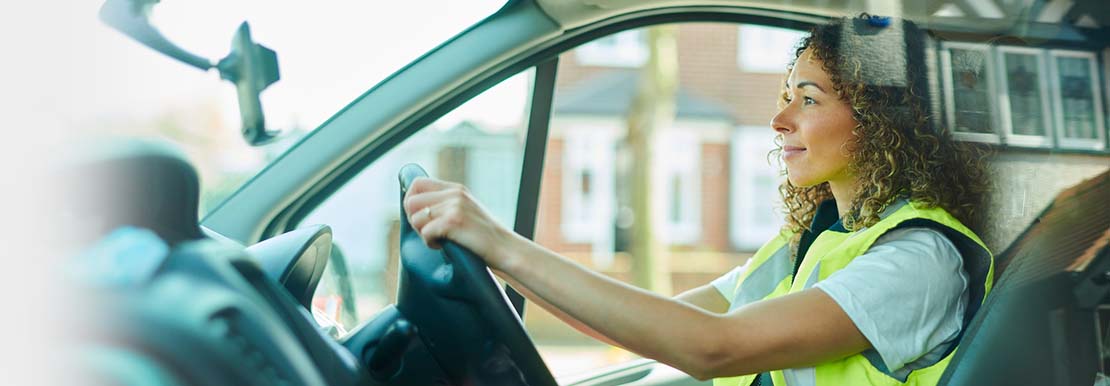
Drivers
What are the driving licence requirements to drive a minibus?
The licence category you will need to drive a minibus will depend on the purpose for which you are driving, the organisation you are working for and the date you obtained your full (manual) car licence.
Vocational drivers, drivers who are contracted, self-employed owner drivers and employees required to drive a minibus as part of their duties will need to obtain the category D or D1 (Passenger Carrying Vehicle PCV) entitlement. These drivers will also need to complete 35 hours of driver CPC in five yearly periods.
You may be able to drive a minibus for non-commercial purposes, but this will be dependent on when you obtained your full car driving licence (manual car).
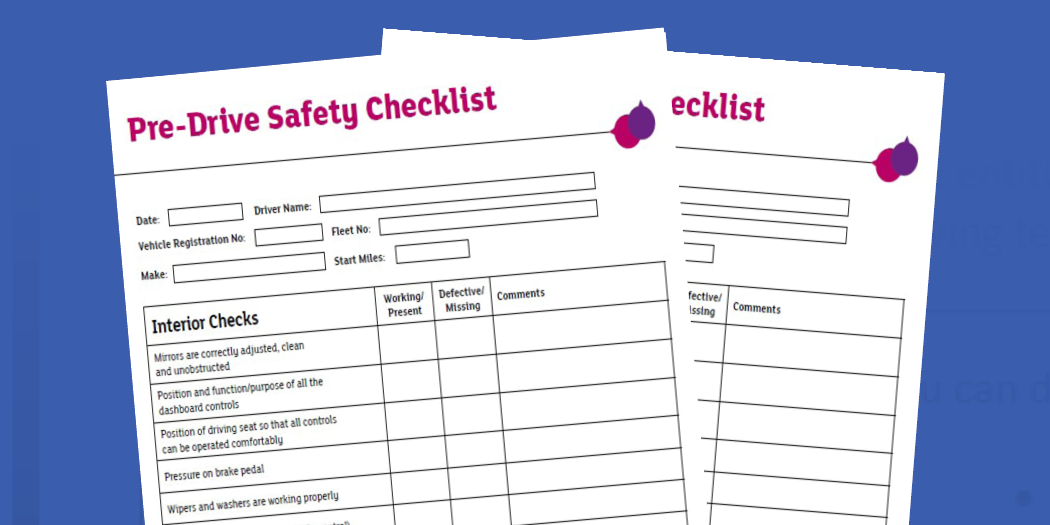
Minibus Safety: Pre Drive Safety Checklist
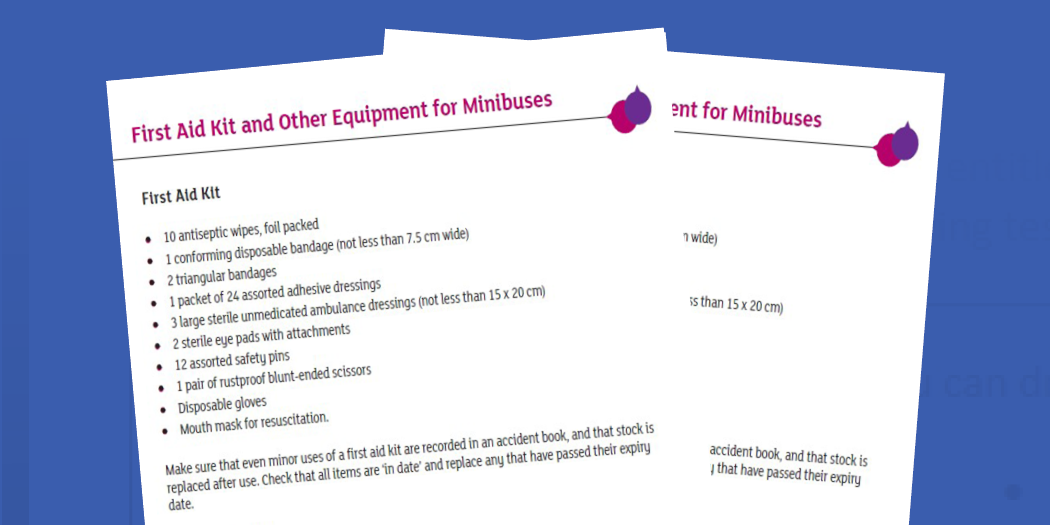
First Aid Kit and Other Equipment for Minibuses
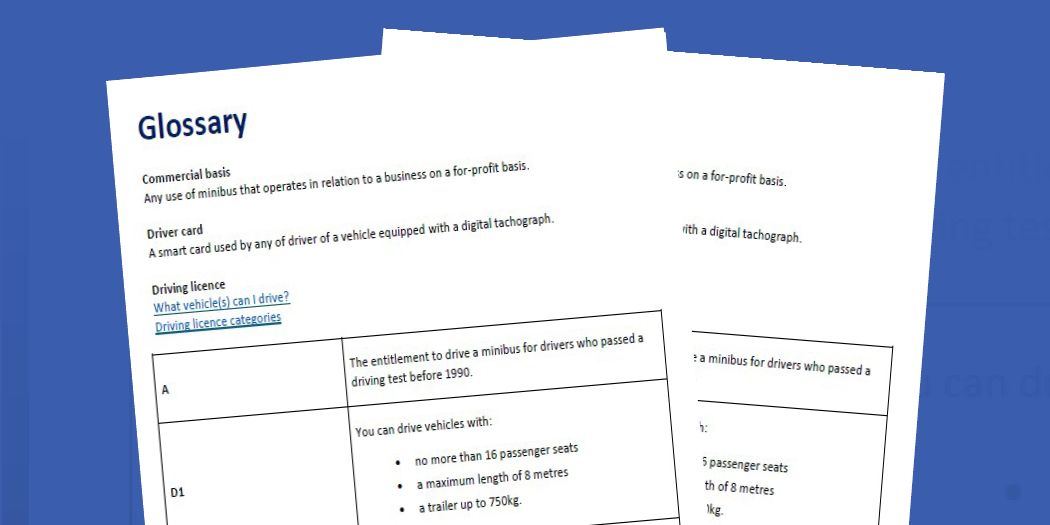
Glossary
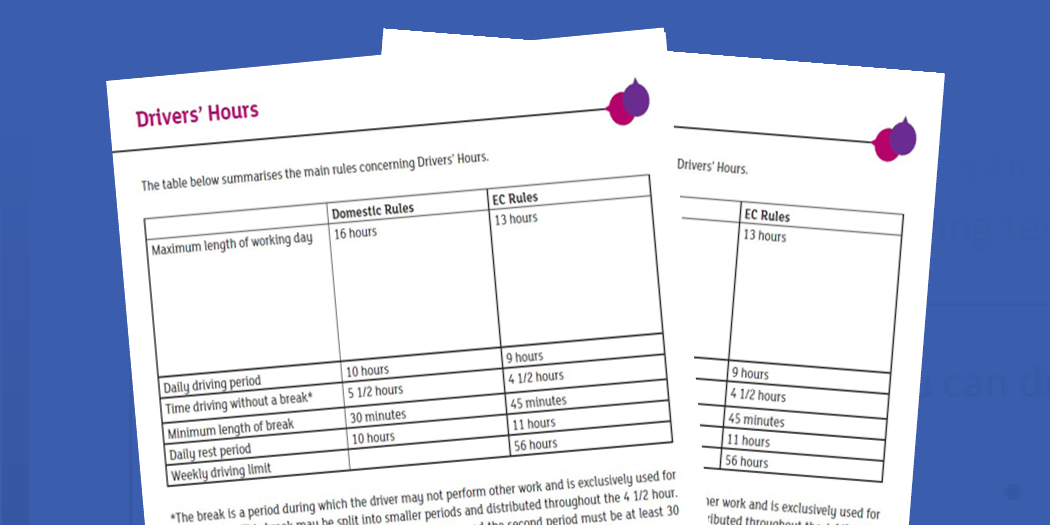
Drivers hours
For car licences obtained before January 1, 1997:
|
For car licences obtained on or after January 1, 1997:
|
-
Your licence includes D1 entitlement with the 101 restriction (not for hire and reward)
-
You may drive a minibus as an occasional driver or a volunteer driver under a section 19 permit
-
If you change your name or address, you will have to apply to keep the D1 entitlement on your licence.
|
- You may drive a minibus designed to carry no more than eight passengers (not including the driver).
|
Do I need a minibus licence if I am not driving for commercial purposes?
If you are a volunteer driver, and you do not have a D1 or A entitlement, you can drive a minibus on your car licence if:
-
You do not receive any payment for driving the minibus, other than out of pocket expenses (e.g. fuel)
-
You are over 21-years-old but under 70-years-old
-
You have held your full car licence for at least two years
-
You are 70-years-old or older, have renewed your licence and passed a PCV medical test
-
The total weight of the minibus including passengers is not more than 3.5 tonnes – plus up to 750kg of equipment for disabled passengers, for example a wheelchair ramp
-
The minibus is being used by a non-commercial organisation for social purposes but not for hire or reward (unless it is operated under a section 19 permit (section 10b in Northern Ireland))
-
You do not tow a trailer.
An interactive flowchart that allows people to check what vehicles their driving licence entitles them to drive is available on the Government website.
Do I need a minibus licence if I am driving a minibus for a school?
Government advice states that;
“There are circumstances in which a member of school staff with a car driving licence (category B) can drive a minibus” and “Schools are also advised to check their insurance and any employer’s policies on this matter.”
and
“if the terms and conditions of a teacher’s contract of employment state that driving minibuses is a part of their duties, or if a teacher is paid an additional sum specifically for driving the minibus (other than a sum to reimburse the teacher for out of pocket expenses on a cost recovery basis), such staff would be deemed as receiving payment for driving a minibus and would not be driving the minibus ‘on a voluntary basis’. In these cases, a full D1 licence (or a full D licence) would be needed. “
However,
“if a teacher’s contract of employment does not state that driving minibuses is part of their duties and they receive no additional payment for driving a minibus to take pupils on trips or to social sporting events (except for reimbursement for out of pocket expenses), they will be driving on an extra-contractual, voluntary basis. In this case, the category B licence would suffice (assuming the conditions are met) even if the school reimburses the teacher for fuel, parking and tolls.”
Operators should note that the Government’s advice document is not legal advice, and any operator or driver who is unsure about whether they meet the requirements to use the exemption for ‘volunteer’ drivers should seek independent legal advice. Some local authorities require drivers to have a D1 licence, even if they are driving under a permit scheme.
When will my licence expire?
Category B & Category D1 (if obtained before 01/01/1997):
The day prior to your 70th birthday.
Category D / D1 (if obtained by taking the vocational driving test):
If you apply to claim your first bus test pass (D1, D, D1E or DE) or renew your driving licence on or after January 19, 2013, the licence issued will be valid for a maximum of five years. Once you’ve been issued with a five-year licence, you’ll need to renew the licence when it expires. To renew the licence and to renew bus entitlement you’ll need to fill in the application and medical questions on an application for a lorry, bus or minibus driving licence (D2) or the renewal reminder form.
From the age of 70, the renewal period is every three years. If you have a notifiable medical condition, the DVLA may also require you to renew your licence at shorter intervals.
What is the speed limit for minibuses?
Drivers should understand, and must comply with, speed limits that apply to minibuses.
|
Built up roads
|
30 mph (Unless signed otherwise)
|
|
Single Carriageway
|
50 mph (Unless signed otherwise)
|
|
Dual Carriageway
|
60 mph (Unless signed otherwise)
|
|
Motorway
|
70 mph (Unless signed otherwise)
|
|
Motorway
|
60 mph (if minibus is longer than 12 metres)
|
How many hours can I drive a minibus for?
Operators should set and implement clear policies on driver hours and journey planning to ensure their drivers do not drive when too tired. Clear rules on drivers’ hours should be set and enforced.
Drivers should ensure they are well rested before driving and take regular rest breaks on long journeys.
Operators should consult and follow the Drivers' hours rules and guidance and the advice set out for buses and coaches.
Do I need to follow the EU and domestic drivers' hours?
The EU rules apply if the maximum weight of your vehicle or vehicle combination is more than 3.5 tonnes and you’re driving either:
The table below sets out the main rules concerning drivers' hours
|
|
Domestic Rules
|
EU Rules
|
|
Maximum length of working day
|
16 hours
|
13 hours
|
|
Daily driving period
|
10 hours
|
9 hours
|
|
Time driving without a break
|
5 ½ hours
|
4 ½ hours
|
|
Minimum length of break*
|
30 minutes
|
45 minutes
|
|
Weekly driving limit
|
|
56 hours or 90 hours in two consecutive weeks
|
|
Unbroken rest period
|
10 hours between two working days (or spreadovers) - this can be reduced to 8.5 hours up to three times a week.
Every two weeks you must take at least one period of 24 hours off duty.
|
45 hours every week, which can be reduced to 24 hours every other week
|
* The break is a period during which the driver may not perform other work and is exclusively used for recuperation. This break may be split into smaller periods and distributed throughout the four and a half hours. In this case, the first period must be at least 15 minutes, and the second period must be at least 30 minutes. With each additional driving period, the break time should be extended.
Drivers should not be required to supervise children during their break, as this would not be a rest for the driver.
Drivers should never be expected to do a day’s work (regardless of the type of work), or be awake for a day and then drive for several hours in the evening.
On journeys lasting several days, fatigue caused by consecutive days on duty must also be taken into account. Drivers’ Hours rules specify weekly rest periods.
Second drivers should also have adequate rest breaks, without being required to supervise children.
What are the rules for driving a minibus abroad?
Operators should ensure that they are aware of, and follow all necessary rules and regulations for international journeys and for all the countries in which they travel.
-
A tachograph must be fitted and used for international journeys (except in Eire). Drivers must be trained in the use of the tachograph as misuse may lead to prosecution or spot fines. Drivers Hours Regulations must be followed from the start of the journey in the UK.
-
If the minibus was first registered on or after 1 May 2006, it must be a digital tachograph.
-
Section 19 Permits (Section 10B in Northern Ireland) are not valid abroad. Therefore, the driver must hold a PCV licence if any payment is made by passengers for the trip i.e. where it constitutes ‘Hire and Reward’.
-
The operator should consult one of the main motoring UK organisations or the country’s Embassy or consulate for further advice. The operator should also consult the vehicle’s insurers regarding insurance cover for the journey and for the countries to be visited.
A list of rules can be found here.
Is my vehicle exempt from EU driving rules?
Some types are vehicles are exempt from EU rules and means that they come under GB domestic rules outlined below. There is a summary of exemptions set out below but for a full list, refer to this guidance.
Exempt from EU Drivers' Hours
|
Detail
|
Drivers' Hours
Rules Applying
|
|
Vehicles used for the carriage of passengers on a service that does not exceed 50km
|
You will need to demonstrate that the service runs to a timetable, along a specified route, with passengers being taken up and set down at pre-determined starting points.
|
Domestic
|
|
Vehicles driven by company employees who are never engaged in the carrriage of passengers
|
This includes vehicles being delivered, collected, moved between branches or taken to an annual test
|
Domestic
|
|
Vehicles used under section 19 or 22 permits by volunteer drivers
|
This could be schools, volunteer groups, or activities that benefits the community
|
None
|
|
Vehicles used under section 19 or 22 permits by employee drivers
|
As above
|
Domestic
|
|
Vehicles used by the police, fire and armed forces
|
Any use of a minibus that relates to these services
|
None
|
|
Vehicles used for emergencies, rescue operations or medical purposes
|
Any use of a minibus that relates to these services
|
Domestic
|
You can also refer to a full list of EU/AETR rules and exemptions
What documents do I need to drive a minibus abroad?
Operators must ensure that all the necessary documentation for journeys abroad is carried. The requirements may vary according to the country or countries being visited and further advice should be obtained.
Some or all of the documents below will be required:
-
Full driving licence with appropriate entitlement
-
International Driving Permit or translation of licence (for some countries)
-
Full passport (for everyone in the vehicle)
-
European Health Insurance card (for everyone in the vehicle)
-
Letter of authority to drive the minibus
-
Tachograph charts or Drivers’ Card for a digital tachograph
-
Waybill and/or Own Account Certificate
-
Model Control Document
-
Vehicle Registration Document
-
Green card (international motor insurance certificate)
-
If any payment is made by or on behalf of passengers a full PCV driving licence (see ‘Hire and Reward’ in the Glossary)
Do I need an analogue or digital tachograph?
Minibuses must be fitted with tachographs as required by law.
Except as detailed below, vehicles used for the carriage of passengers with more than nine seats, including the driver’s seat, must be fitted with a tachograph, as follows:
-
A vehicle first registered before 1 May 2006 must be fitted with either an analogue or a digital tachograph.
-
A vehicle first registered on or after 1 May 2006 must be fitted with a digital tachograph only.
-
Digital tachographs are used with a Driver Card, which the driver must insert into the tachograph. The Driver’s Card must belong to the driver who is driving the minibus. Further details are available in the DVSA’s guidance “Digital Drivers’ Cards: How to Stay within the Law”.
-
There are some exemptions relevant to minibuses:
-
Vehicles with between 10 and 17 seats used exclusively for the non-commercial carriage of passengers.
-
Vehicles used for the carriage of passengers on regular services with a route that does not exceed 50 km.
However, any minibus that is used abroad must be fitted with a tachograph (from the beginning of the journey in the UK).
Further advice on tachographs can be found through the Government website
How can I plan a long journey?
-
A well-planned journey reduces the risk of drowsiness and falling asleep at the wheel, and is more efficient, saves time, stress and fuel. Operators should set out rules and procedures for journey planning, and ensure that their drivers are aware of, and adhere to, these rules.
-
Operators, trip organisers and drivers should ensure that each journey is planned in advance in terms of its time and distance, and their own, and their passengers’ comfort. Further advice is available from RoSPA and the HSE.
How can I transport passengers safely?
Boarding
When boarding, never allow passengers to board until the minibus is at a complete standstill and safely parked by a pavement or traffic free area. Make sure the passengers enter the minibus from the pavement (unless using a ramp or lift at the rear). If the nearside door opens onto the road, take extra care.
Ensure children are supervised when boarding. Plan which passengers will sit in the front seats and by the doors. Child car seats do not need to be provided in minibuses, but if they are, they must be used by children who are under 12-years-old or under 135cm tall, and fitted correctly. If school bus signs are used, make sure they are in position only while children are being transported, and that they do not obstruct your vision. Consider the need for bus assistants, supervisor, or care assistants.
If a tail-lift or other specialist equipment is fitted, ensure that you have the correct training to operate it and always comply with the manufacturer’s instructions. Never allow passengers (or untrained staff) to operate any equipment.
Make sure you have a list of the passengers being carried and any medical or additional needs, checking that passengers have any necessary medication with them. Keep the list where it can be readily found in the event of an incident. If you have a passenger with an oxygen cylinder, display signs to warn emergency services in the event of fire. These should not be displayed if there is no oxygen on board.
Ensure that you are not exceeding the carrying capacity of the minibus. Make sure everyone is sitting, one to a seat, and that all passengers are wearing their seatbelt and that you are wearing yours. Before setting off, check that no bags or clothing are caught in the doors, all luggage is secured, and that gangways and exits are clear. Finally, check all mirrors before moving away in case latecomers are approaching the vehicle.
During the journey
If you leave the vehicle, switch off the engine and remove the key.
Do not leave children unaccompanied in the minibus. If there is a serious delay during the journey, inform the school or organisation so that information may be passed to parents.
At the end of the journey
Avoid unnecessary reversing, but if it is unavoidable, seek adult assistance for direction and ensure no one stands directly behind the minibus.
Always park so that passengers step onto the footway and not the road. Never allow passengers to leave until the minibus is at a complete standstill and parked by a pavement or other traffic free area, with the handbrake engaged.
Ensure passengers are supervised when leaving the minibus. Do not leave children or vulnerable passengers alone if no one has arrived to collect them. Ensure you know what to do if a passenger is not collected.
What do I need to check before driving a minibus?
A pre-drive inspection of the vehicle is important for safety and compliance reasons. As the driver, and once on the road, you are responsible for the condition of your vehicle, ensuring that it is safe and legal, is not overweight, that all necessary equipment is working correctly and that you have sufficient fuel for the journey.
Pre-drive check
It is recommended that you conduct a pre-drive check every time you drive the minibus. Your minibus operator may provide a checklist.
-
Walk around the minibus, including the trailer if applicable, to check for visible defects and the items in the checklist
-
If you are unsure how to do these checks, read the vehicle handbook, and/or ask someone to show you.
Loads and luggage
Ensure that the minibus is not overloaded (check the handbook or the plate on the vehicle for the maximum weight). If you are not sure whether it is overloaded, take it to a public weighbridge.
Trailers
Only use a trailer if you have an E category on your driving licence (e.g., D1 + E), and you have been trained to drive with one.
Ensure that you know how to connect the trailer, including the electrical connections, that it is not overloaded and that the weight is evenly distributed and securely covered. Make sure no items are sticking out.
Lower speed limits apply to minibuses with trailers: 50mph on single carriageway roads and 60mph on dual carriageways and motorways. Minibuses with trailers are also prohibited from using the outside lane on motorways with three or more lanes.
Roof rack
If you use a roof rack, make sure it is securely fitted, the load is evenly distributed and securely fastened. You should consider how, and where, you can safely load and unload things in a roof rack.
If you find any problem during the check, report it to your manager immediately.
Equipment
It is a good idea to have the following equipment available:
-
British Standard fire extinguisher of water or foam, with a minimum test rating of 8A or 21B (If there are passengers in wheelchairs, then the minibus should be equipped with two fire extinguishers.)
-
First aid box (legally required)
-
Hi-visibility tabards/jackets complying with BS EN 471 or BS EN ISO 20471
-
“Break-glass” hammers and seatbelt cutters should be carried on the minibus and are a requirement if one of the emergency exits is of the “break-glass” type
-
Mobile phone, phonecard or change for the phone
-
Emergency warning triangle or a flashing beacon (not fitted to the vehicle)
-
Emergency contact details.
For advice on planning your journey and fitness to drive, take a look at our safer driving for work handbook.
What should I do after my journey?
At the end of your journey, conduct a post trip vehicle check, inside and outside the minibus, and record any visible damage or faults, any emergency equipment that has been used and any incidents that have occurred during the journey.
Report any faults to the minibus operator as soon as practicable, and do not use the minibus until the fault is rectified. If the operator has provided a reporting form or procedure, follow this.
What should I do in the event of a breakdown, collision or emergency?
The minibus operator should provide clear written procedures for you to follow in the event of a breakdown, collision or other emergency (such as passenger illness). Keep a copy of these procedures, contact details of who to contact in an emergency and of a breakdown firm and any reference numbers you may need to quote.
Make sure you have a fully charged mobile phone to summon help if necessary, but do not use the phone while driving.
Breakdowns
Move the passengers out of the nearside of the minibus and as far away from traffic as possible. Don’t let anyone stand behind the minibus. On motorways or other busy roads, take the passengers onto the embankment or grass margin and as far from the traffic as possible. In some circumstances, it is safer to leave passengers in the minibus.
For example, if it seems too dangerous to unload passengers in wheelchairs or if there is not a safe waiting area. You will need to assess the situation and decide whether or not to unload passengers. Keep passengers together in one group and under supervision. Do not allow child passengers to assist with repairing or restarting the minibus and never allow them to push the minibus.
If necessary, go for help, leaving the passengers with the passenger assistant, but if you are the only adult present, do not leave children alone. Give the police or breakdown service accurate details of the location and let the operator know if children or passengers with mobility problems are being carried. After calling for help, telephone your contact to tell them what has happened and ask them to relay messages to parents and others.
Collisions
In the event of a collision, follow the above advice for breakdowns. If any passengers are injured, do not move them unless they are in immediate danger of further injury.
Report the incident to the minibus operator on your return.
Emergency evacutaions
The best way to evacuate the minibus will depend on the incident, the passenger group and the type of minibus. You will need to exercise your judgment at the scene. You should follow the advice for breakdowns as above.
It may not be possible to remove wheelchairs quickly from a minibus, unless you are trained to do so. It may be necessary to lift a passenger from the minibus, which is not easy to do in a confined space and often requires two people.
Do not attempt to tackle a vehicle fire, unless you have been trained to do so.